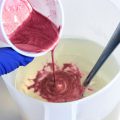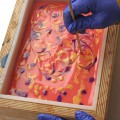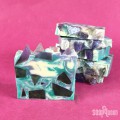Click here for Day One – Set Up & Ingredient Explanation
Click here for Day Two – Fragrance & Color
As mentioned yesterday, there are a two main ways to color your Talc Powder:
1. Micas – Micas are a natural product that form a flat platelet. This flat platelet is then colored, either with natural or non-natural colors, to form a shimmery, diamond-like color. Micas form the base of most eye shadows and provide the shimmer you see in lipsticks and nail polish. In body powders, micas add a subtle color with a little sparkle.
2. True Tones, Labcolors or other FD & C water-based colorants – These colors are normally used in soaps, lotions, bath fizzies and provide color in most make-up, including lipsticks. These water based colorants are a little trickier to use in dry powders but provide a more defined, bright color. Per use, they are more economical than micas.
The photo above shows the color achieved with Fuchsia True Tone color in the powder. It took just 3 mls (a full dropper) of color in 8 ounces of dry powder to get the bright color in the photo above.
3. Other Additives – Spices, ground herbs, and ground flowers can add color, texture and even scent to your powder. Many times, these items can be scratchy though. Be sure to check the grain of the product to ensure that it won’t irritate skin and doublecheck that the product is skin safe. Also, ground spices and herbs may leave fine bits of herb detritus, often colored, on the skin. Test batches are very important when using spices, ground herbs and flowers.
This is a recipe that uses ground herbs:
2 oz. Tapioca Powder
1 oz. Arrowroot Powder
1 oz. finely powdered dried chamomile flowers
1 drop Lavender 40/42 Essential Oil or fragrance oil
2 drops 10x Orange Essential Oil
3 drops gardenia fragrance oil
Here’s another powder recipe using ground lavender buds:
1 oz. powdered lavender buds
1 oz. powdered rose petals
optional: 1 tablespoon zinc oxide powder
1/2 teaspoon Lavender 40/42 Essential Oil or Rose Fragrance Oil
Other options for adding fragrance: Some people add their fragrances or essential oils to their powders and allow the entire mix to sit for weeks, shaking daily, prior to shifting. The thought is that the fragrances may better permeate the entire batch if the fragrance sits in the powders before sifting. I haven’t found this to be the case.
Another option to cut down on fragrance clumping is to spritz the fragrance onto your dry powders with a very fine mist spritzer. This does cut down on clumping. However, that first spritz can cause the light powder to poof up and out, covering the surrounding area with a fine dust.
Another option to avoid clumping is to avoid adding fragrance directly to the dry powders altogether. The trade off is less scent in the final product for minimal clumps. Add a fragrance or essential oil saturated cotton balls to a sealed container (zip lock or canning jar) filled with the dry powder mixture. Leave the cotton ball in the dry powder for a week (1 or 2 cotton balls per 16 oz of dry products) and shake daily to impart a subtle scent without clumps like the photo above shows.
Check back tomorrow for making sparkle powder and also a bit of a mess.





Isn’t it fun? One of my employees did it on the weekend and spiffed it all up for me. It was very nice of her. =)
OMG AM!! I disappear for a few days and return to your amazing blog. I LOVE the new look, its adorable. GREAT BANNER!